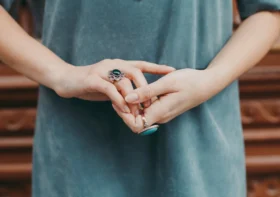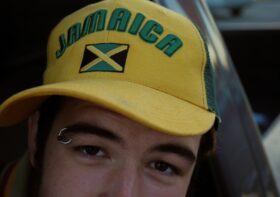The Ultimate Guide to Forward Helix Piercing: Everything You Need to Know

If you’re looking to add some style to your ear, a forward helix piercing might be just what you need. This type of piercing is a great way to experiment with different jewelry and add some edge to your look. However, before you get a forward helix piercing, there are some things you should consider. In this guide, we’ll walk you through everything you need to know about forward helix piercings, from the procedure to aftercare and more.
What is a Forward Helix Piercing?
A forward helix piercing is a type of cartilage piercing located at the top of the ear, just above the tragus. It’s a popular piercing because it’s not as extreme as some other cartilage piercings, but still adds some unique style. Typically, this piercing is done with a small gauge needle, and a piece of jewelry is inserted into the hole.
One thing to note is that forward helix piercings can be done in different locations on the ear, depending on your preference. Some people opt for a single piercing, while others choose to get two or three forward helix piercings in a row. It’s important to discuss the placement options with your piercer to find the best option for your ear shape and personal style.
Things to Consider Before Getting a Forward Helix Piercing
Before you commit to a forward helix piercing, there are some things you should consider. First and foremost, you should make sure you’re comfortable with the idea of getting a cartilage piercing. While forward helix piercings are generally less painful than other cartilage piercings, they still involve puncturing the skin and inserting jewelry. It’s important to be prepared for some discomfort during the healing process.
Another important factor to consider is the healing time for a forward helix piercing. Cartilage piercings generally take longer to heal than earlobe piercings, and a forward helix piercing can take anywhere from 3-9 months to fully heal. During this time, you’ll need to take extra care to keep the piercing clean and avoid irritating it.
It’s also essential to choose a reputable piercer who uses sterile equipment and follows proper sanitation procedures. Before getting a forward helix piercing, research piercers in your area and read reviews from previous clients. You should also ask about the piercer’s experience with cartilage piercings and their aftercare recommendations.

Forward Helix Piercing Procedure
Once you’ve decided to get a forward helix piercing and chosen a reputable piercer, it’s time for the procedure. The piercing itself is relatively quick, usually taking just a few minutes. However, it’s important to be prepared for some discomfort during the process.
During the piercing, the piercer will use a small gauge needle to create a hole in your ear. They will then insert a piece of jewelry into the hole and secure it in place. The type of jewelry used will depend on your personal preference and the placement of the piercing.
After the piercing is complete, your piercer will give you detailed aftercare instructions. It’s important to follow these instructions carefully to ensure proper healing and avoid complications.
Pain and Healing Time for a Forward Helix Piercing
As mentioned earlier, forward helix piercings can be uncomfortable during the healing process. Some people experience mild to moderate pain, swelling, and redness around the piercing site. However, the level of pain varies from person to person, and some people may not experience any discomfort at all.
The healing time for a forward helix piercing can also vary, depending on the individual and their aftercare routine. On average, it can take anywhere from 3-9 months for a forward helix piercing to fully heal. During this time, it’s important to avoid sleeping on the piercing, touching it with dirty hands, or exposing it to harsh chemicals or irritants.
Aftercare for a Forward Helix Piercing
Proper aftercare is essential for the healing of your forward helix piercing. Your piercer will give you detailed instructions on how to care for your piercing, but here are some general tips to keep in mind:
- Clean your piercing twice daily with saline solution or a mild antibacterial soap.
- Avoid touching your piercing with dirty hands.
- Avoid sleeping on the side of your piercing.
- Avoid exposing your piercing to harsh chemicals or irritants.
- Be patient and gentle with your piercing during the healing process.
Common Problems with Forward Helix Piercings
While forward helix piercings are generally safe and well-tolerated, there are some potential complications to be aware of. One of the most common problems is infection, which can occur if the piercing is not kept clean or if the jewelry is not properly sterilized. Symptoms of an infected piercing include redness, swelling, pain, and discharge. If you suspect your piercing is infected, seek medical attention immediately.
Another potential issue with forward helix piercings is keloid scarring. Keloids are raised, thickened areas of scar tissue that can develop around a piercing. While not harmful, keloids can be unsightly and may require medical treatment to remove.
Infected Piercing: Symptoms and Treatment
As mentioned earlier, an infected piercing can be a serious problem and should be addressed immediately. If you notice any of the following symptoms, seek medical attention right away:
- Redness and swelling around the piercing site
- Pain or tenderness
- Discharge or pus
- Fever or chills
Treatment for an infected piercing typically involves a course of antibiotics and proper wound care. In some cases, the jewelry may need to be removed to allow the infection to heal. It’s important to follow your doctor’s instructions closely to ensure a full recovery.
Forward Helix Jewelry: Types and Styles
One of the great things about forward helix piercings is the variety of jewelry options available. From studs to hoops to unique designs, there’s something for everyone. Some popular types of jewelry for forward helix piercings include:
- Threadless jewelry
- Captive bead rings
- Labret studs
- Hoops
- Hinged rings
- Clickers
- Cluster and chain earrings
- Studs with unique designs
When choosing jewelry, consider your personal style and placement. Some jewelry styles may be more comfortable or secure depending on the location of the piercing.
Double and Triple Forward Helix Piercing
If you’re looking for even more style and edge, you may want to consider a double or triple forward helix piercing. This involves getting two or three forward helix piercings in a row, creating a unique and eye-catching look. However, it’s important to discuss the placement and healing process with your piercer before getting multiple piercings.
Frequently Asked Questions about Forward Helix Piercing
Here are some common questions and answers about forward helix piercings:
How long does a forward helix piercing take to heal?
On average, it takes 3-9 months to recover fully.
Does a forward helix piercing hurt?
While everyone’s pain tolerance differs, a forward helix piercing is generally less painful than other cartilage piercings.
Can I sleep on my forward helix piercing?
It’s best to avoid sleeping on the side of your new piercing during the healing process.
What should I do if my piercing gets infected?
If you suspect your piercing is infected, seek medical attention right away.
Conclusion
A forward helix piercing is a great way to add style and edge to your ear. While it’s important to consider the healing time and aftercare involved, a forward helix piercing can be a fun and unique addition to your look. Following proper aftercare instructions and choosing a reputable piercer can ensure a safe and successful piercing experience.



